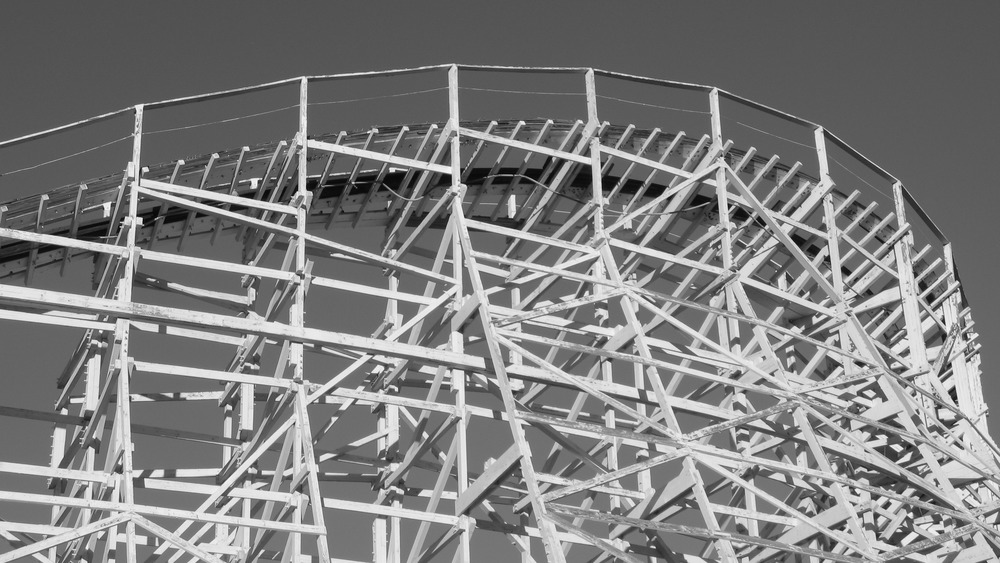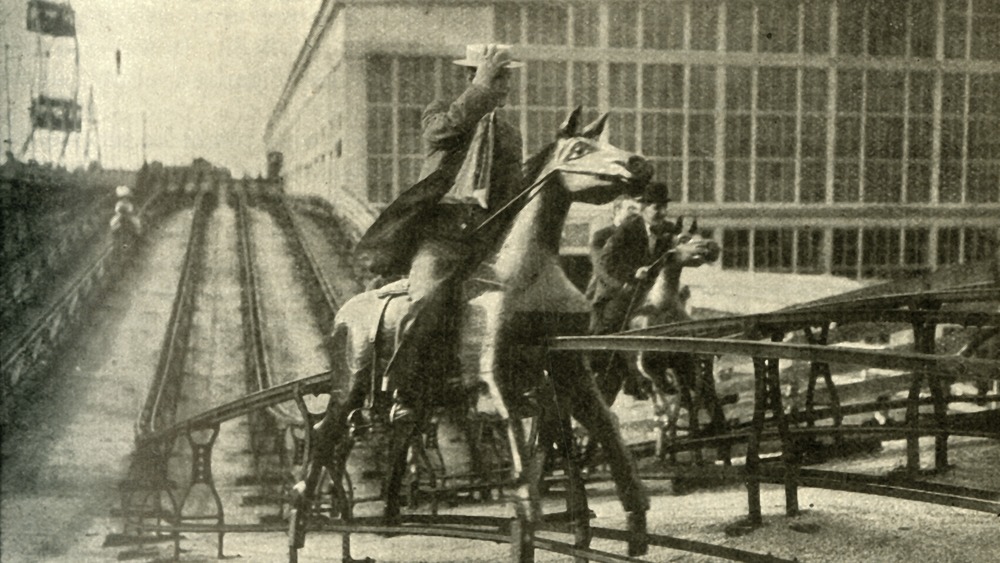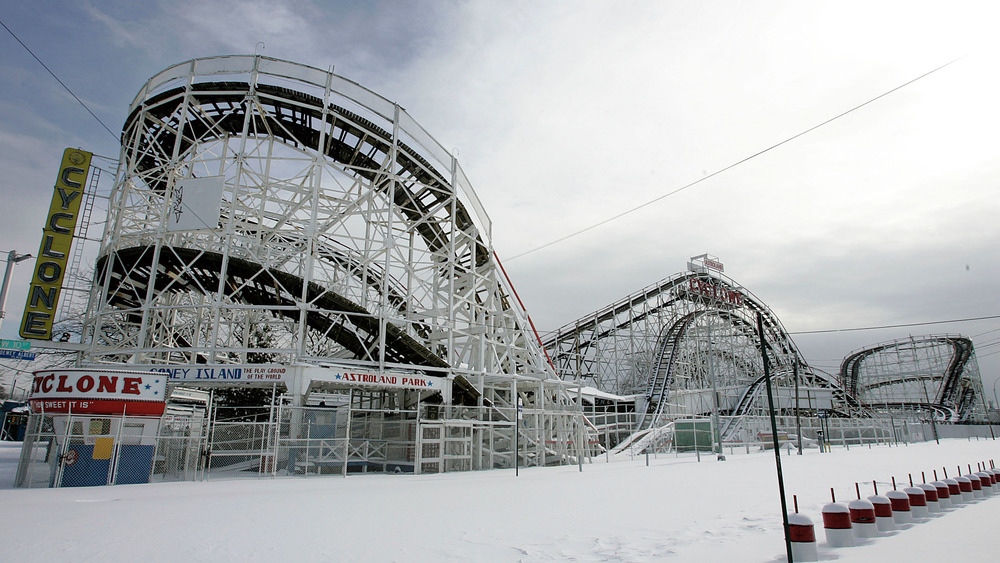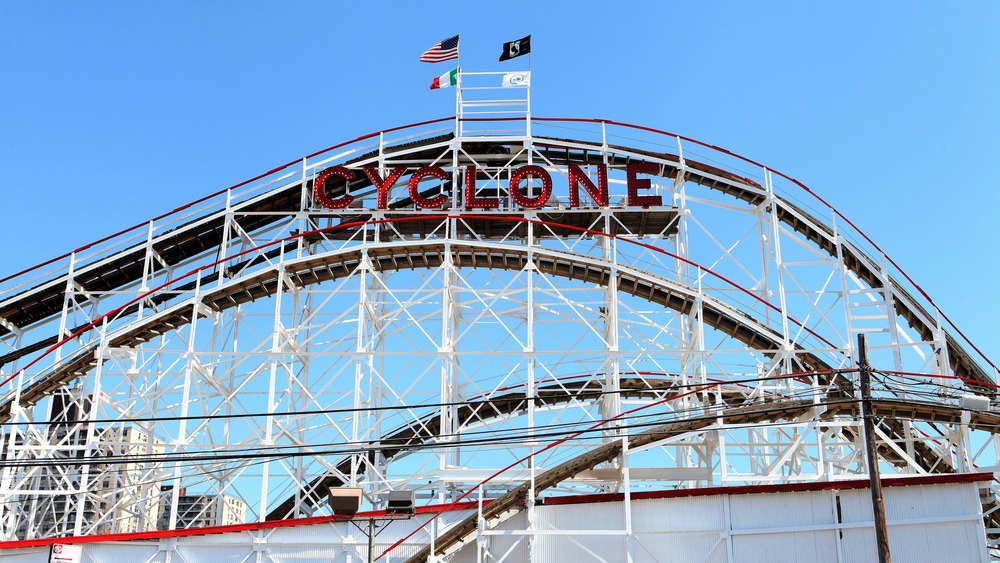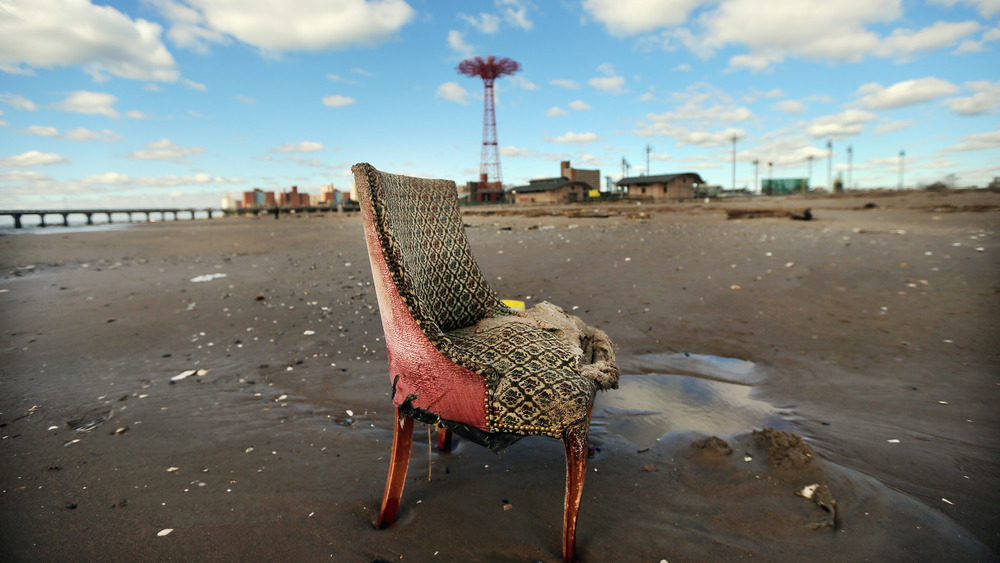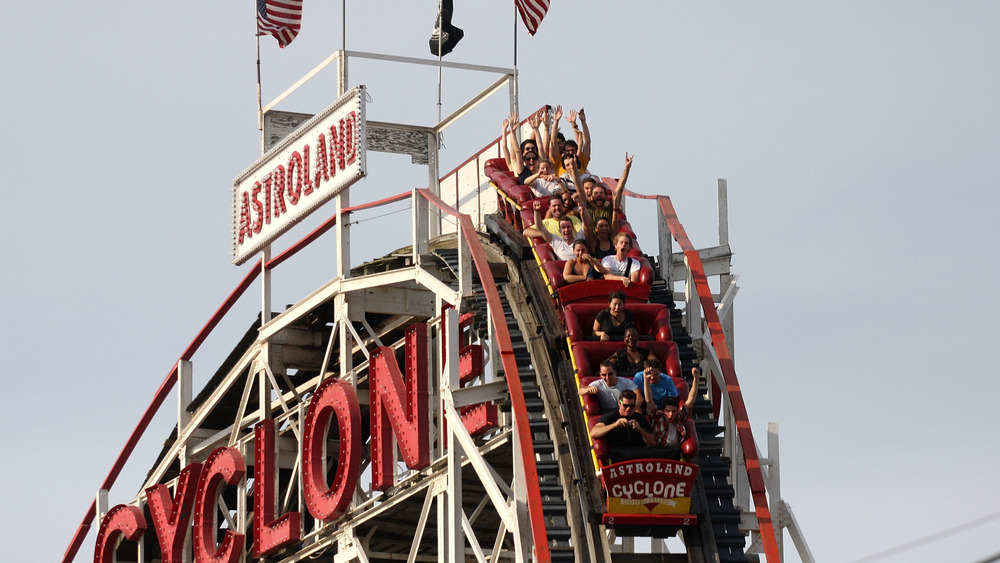The Truth About Everyone Who's Died At Coney Island
Brooklyn is many things, and as Brownstoner points out, the experience starts with Coney Island. The famed waterfront area is the first thing people see of New York City's most populous borough when they approach from the sea. It's well worth seeing, too, with its legendary boardwalk, swath of sandy beach, and a vast history of amusement parks.
Coney Island has a long and storied history as an entertainment hub. Ever since the building of the Coney Island House hotel in the 1840s, it has been an area of hotels, games, relaxation, and a jolly good time. It's the kind of place where people go to take their mind off their everyday troubles, and where the worst thing you expect to end the day with is windswept hair and a feeling that you shouldn't have eaten quite this much candyfloss. It's decidedly not the kind of place where you expect the day to end in a tragedy.
Unfortunately, for some people, that's precisely what the area has been. Over the years, Coney Island has developed a grim undercurrent of nasty accidents and amusement park ride malfunctions, which have sometimes resulted in casualties. Here's a look at the dark side of this merry place and the many people who have died on Coney Island.
The Rough Riders roller coaster turns deadly
Coney Island's famed amusement rides are a far cry from the slick and sleek affairs of, say, Disneyland, according to Mental Floss. Still, rustic attractions like the Wonder Wheel and the Cyclone may creak and groan, but they still have a long way to go before they're as deadly as Rough Riders, the deadliest ride Coney Island has ever hosted.
The Theodore Roosevelt-themed Rough Riders debuted in 1907 and was propelled by an electric third rail. Special "conductors" dressed in period clothing watched over the cars and were in charge of controlling the speed. The technology was similar to the ones used in subways, but unfortunately, it proved to be a colossally bad idea to give park employees free rein over the ride's brakes.
The manual operation system of Rough Riders meant that it set a lot of stake for the conductor's ability and willingness to keep things safe. Unfortunately, not all of them did. On the contrary, multiple operators made their cars go as far as possible, instead of regulating the speed on some of the sharper turns and steeper drops. In 1910, this resulted in a tragedy when one coaster hit a turn far too fast. As a result, the uncompromising laws of physics sent 16 people flying from their seats. Four people died in the incident.
Rough Riders claims its final victims
One would expect that after a traumatizing accident that throws 16 people off a roller coaster car and kills four of them, the ride in question would never be used again. However, the 1910s were a different time. Despite the fact that Coney Island's Rough Riders coaster had the aforementioned fatal incident in 1910, it remained in use for five more years, per Mental Floss.
The attraction's luck ran out on July 27, 1915, when a conductor took a car too fast into a curve, and the car fell onto its side. As a feat of truly amazing strength and endurance, one woman managed to hold onto a railing on one hand and cling to her four-year-old son with another until they were both rescued. The conductor and the other four of the car's six riders, on the other hand, were less fortunate. They were sent flying through the air until they hit the track enclosure's flimsy iron fence. It couldn't withstand the impact, and three of the poor people died when they fell 30 feet onto the concrete. What's more, one of the bodies hit an otherwise uninvolved lady on the way down, injuring her to the point of hospitalization.
This incident was enough for the authorities, and the ride's manager was charged with homicide. Though the jury eventually found him innocent because the incident was "unavoidable," the ride's days were numbered. In 1916, Rough Riders was shut down for good.
Coney Island's park manager dies on the premises
Not every dramatic death in an amusement park has to do with awful ride malfunctions. As a place with a constant influx of visitors, it's only to be expected that Coney Island has also seen the occasional conventional medical emergency over the years. As Coney Island Central and City Beat tell us, perhaps the most dramatic of these non-ride-related incidents came in 1935, when George F. Schott suffered a fatal heart attack on the premises.
Schott was the amusement park's well-known president in the 1920s and 1930s and a man who'd worked tirelessly to turn the area into an entertainment juggernaut. One of his notorious projects was the meeting and dancing area known as Moonlight Gardens — which, thanks to a strange twist of fate, also became the very last place he visited. On July 25, 1935, the 57-year-old Schott was visiting this area late at night, when he unexpectedly fell in the middle of a conversation with business associates. He died of a sudden heart attack, right in the middle of his beloved park.
Fortunately, Coney Island endured and even continued to have a Schott in the helm — Edward L. Schott followed in his father's footsteps, becoming Coney Island's president and general manager at just 28 years old.
A child falls off the Steeplechase Horses
A deadly accident is always tragic but doubly so when a helpless child is involved. Per Brownstoner, Coney Island saw such a horrible incident in 1935, when a 10-year-old boy fell off from a horse-themed ride and perished.
As Westland tells us, this was the time of Coney Island's second Steeplechase Park, which had opened with much fanfare in 1908. One of the park's main attractions was the Steeplechase Ride, in which park patrons could race mechanical horses through a 1,600- or 1,700-foot track course. The ride was pretty elaborate but a far cry from modern standards. The horses were first drawn to an elevated starting position, and when released, they basically relied on momentum to plunge through the course, which included a tiny lake and a tunnel.
If that sounds potentially dangerous, well — you're not wrong. Though there were precautions in place, accidents sometimes happened. The worst one came on Aug. 6, 1935, when young John Barke fell off his horse at the second turn of the track. The poor boy fell 10 feet to a platform below and suffered a fatal head injury.
Standing up on the Coney Island Cyclone can be deadly
Coney Island's iconic Cyclone was built in 1927, on the back of the success of past coasters like the Thunderbolt and the Tornado, according to William J. Phalen's book, Coney Island: 150 Years of Rides, Fires, Floods, the Rich, the Poor and finally Robert Moses. Per Brooklyn History, the wooden coaster has since become quite literally a national icon. In 1988, it became an official New York City landmark, and in 1991, its charms were deemed sufficient to give it the status of a National Historic Landmark. As the ride's operations manager Jennifer Tortorici made it clear to NBC New York in 2012, the Cyclone is certainly one of the more addrenaline-inducing members of that particular list. "It's 2,640 feet of track, so if it wasn't slow in certain areas, the cars would wind up on the beach somewhere," she said. Tortorici also revealed that the Cyclone's ride can be so bumpy that patrons have been known to lose wigs, dentures, and even underwear during the ride.
With forces like that at play, the elderly Cyclone is unfortunately not without its tragedies. Only six years before its inclusion on the list of National Historic Landmarks, the 85-foot-high ride with a top speed of 60 mph proved deadly to one rider. On May 28, 1985, a 29-year-old man stood up while riding the Cyclone, and his head hit a crossbeam. He didn't survive the incident.
A park worker's fatal joyride
Coney Island's rides can sometimes be dangerous for visitors, but park employees aren't always safe from them, either. According to the The New York Times, this became painfully clear in the summer of 1988, when a 26-year-old park maintenance worker named Peter Ellis was riding the Cyclone roller coaster but suddenly fell from his car. The poor man died instantly when he landed on a crosstie in a lower part of the track.
The authorities looked into the case, and it soon transpired that Ellis had taken his joyride in a rather unconventional — and forbidden — way. "The roller coaster went up the first hill, and while coming down, witnesses report he was standing up,” Detective Joseph McConville described the incident. Though there are several signs that warn riders against standing, and the coaster's cars are equipped with safety bars that should prevent it, McConville noted that ”apparently you can slip out if you're sitting alone.”
The ride was immediately closed after the tragedy but eventually opened after the staff ran safety checks.
The Super Himalaya ride malfunctions in a horrifying way
In 1999, one Coney Island visitor's worst nightmares came true when a ride at the Astroland amusement park malfunctioned in an extremely grim and grisly manner. According to The New York Times, a 17-year-old girl was riding the park's Super Himalaya ride when suddenly, a coupling that binds the ride's cars together snapped. As the New York Post tells us, the high speed ride works by "whipping" the cars along the track, and the broken coupling caused the girl's car to violently buck and swivel. Some reports indicate that it even flipped over. "We heard something snap," one survivor described the horrifying situation. "Everyone was screaming. When I looked back, that girl's car flipped over."
The motion of the wild car threw the teenager off her seat, and she flew up to 15 feet, only to land on another car and get pinned between it and the tracks. Though she was reportedly conscious after the accident, she died at the hospital a mere hour later. Her relatives said that she'd received internal and head injuries.
As a small silver lining, everyone else on the ride got away with just minor injuries. Unfortunately, two of the survivors were the dead girl's sisters, who were also on the ride and had to witness the incident.
A drowning at the beach
The Coney Island experience is at least as much about the seaside as it is about the rides, but unfortunately, the beach has also claimed lives. As The New York Times tells us, one particularly strange incident happened in 2005, when a 24-year-old man from Queens was spending a day at the beach with his friends. Reportedly, the group was in the water just by the amusement park when the young man went under the waves.
Here's where things get strange. The friends say that they informed the lifeguard that the man was in trouble — but according to them, the guard didn't conduct a proper search but simply waddled in the water up to his waist. Another eyewitness says that she saw the man having trouble, but when she told a lifeguard, he didn't appear to believe that there was a real situation. The authorities later presented a rather different version of the events and said that they sprang to action as soon as they were alerted. A police spokesman also stated that the man's friends delayed the report.
Regardless of whose version you're inclined to believe, both sides seem quite certain that there was a gap between the start of the man's troubles and the start of a proper search. Though the man was eventually found near a jetty and rushed to the hospital, he didn't survive the ordeal and died later that day.
Another tragic day at the Coney Island beach
The year 2005 was a bad one for Coney Island beach. Just weeks after a 24-year-old man went under and died at the hospital, another young man met his fate in the area, according to The New York Times. The police received a report about a missing 20-year-old man at around 8:20 p.m. and promptly took a helicopter over the beach. They were able to locate the man with a thermal camera, and two divers took him to dry land. He had been quite close to the shore — just under 30 feet.
While the man had a pulse when he was rescued, it was too late for him, as rescue workers soon found that he wasn't breathing. He was taken to a hospital, but all they could do was pronounce him dead. The exact events that led to his highly untimely demise are shrouded in mystery. The tragedy happened after lifeguards had gone off duty, and according to the police, it's not known if he'd been struggling in the water.
The Cyclone breaks a neck
Sometimes, an amusement park ride accident isn't an ultra-dramatic breakdown that sends people flying in blood-curdling ways. Sometimes, it starts out with little more than a nasty sensation in the neck — yet, the end result can be just as awful.
As NBC New York and the New York Post report, that's how the tragedy of Keith Shirasawa's death started. On July 31, 2007, Shirasawa boarded Coney Island's famous Cyclone roller coaster while his girlfriend, Linda Walker, opted to skip the ride. Things took a turn for the tragic after the ride's very first 85-foot drop, as Shirasawa's head reportedly snapped forward. "He came out and had a look of pain on his face and was holding his neck," Walker said. "I asked him what was wrong, and he said something happened, and he had lost the feeling in his fingers." After the fingers went, the sensation in Shirasawa's legs also started to go, and Walker asked a worker to call 911.
Doctors at the Coney Island Hospital soon discovered three fractured vertebrae in Shirasawa's neck, and his condition was deemed an emergency situation that required surgical attention. On August 2, Shirasawa underwent an emergency operation. On August 4, he was dead. The family took the city to court, citing failure to keep the Cyclone safe. Per the New York Daily News, the city eventually settled for $250,000.
A terrible beach tragedy claims the life of a 10-year-old
In July 2014, a particularly sad incident happened on the Coney Island beach. The waves were heavy, and it was so late in the day that lifeguards weren't working anymore, according to CBS New York. A combination of these unfortunate situations led to two young girls treading water and screaming for help. One of them was just 10 years old, and the other one was even younger, according to eyewitness Cory Murray.
Murray was present at the scene and had to face a terrible choice when it became apparent he could only help one of them out of the rough sea. He ended up choosing the younger child, whom another man was struggling to rescue. "Pretty much, I left [the 10-year-old] to go help the little girl, so I tried to help both of them, at least," Murray describes the events. "One dude — there was another gentleman helping me as well — he grabbed the girl. He was having some problems helping her back to the shore, so I told him to put her on my back and I'd bring her halfway, pretty much bring her to safety."
Fortunately, the younger child survived, no doubt thanks to the actions of those present at the scene. Unfortunately, the 10-year-old went under, and when she reappeared minutes later, it was too late, even though she was received CPR at the scene. She was pronounced dead at Coney Island Hospital.

